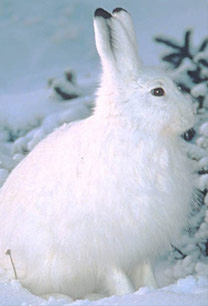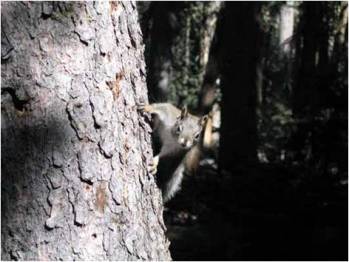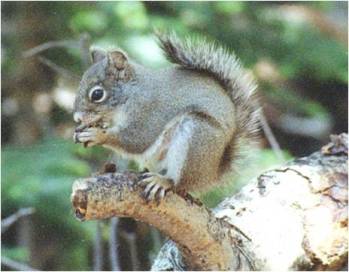Adapted from: Ruggiero, Len; McKelvey, Kevin; Squires, John; Block, William. 2008. Wildlife and Climate Change. (May 20, 2008). U.S. Department of Agriculture, Forest Service, Climate Change Resource Center. http://www.fs.fed.us/ccrc/topics/wildlife.shtml
Issue
Climate change likely will lead to the loss of native species from extensive areas and result in increasingly scarce and fragmented populations in many others. Further changes within ecosystems will be triggered as invasive species, both plant and animal, fill the “holes” that are left as native species are lost, or even help push destabilized natives out of their niches. Associated changes in the food web will cascade and further destabilize ecosystems.
Likely Changes
Species such as the Canada lynx (Lynx canadensis), wolverine (Gulo spp.), snowshoe hare (Lepus americanus), white-tailed ptarmigan (Lagopus leucura), and short-tailed weasel (Mustela erminea) have adapted to snowy environments with fur or plumage that turns white in the winter. With its large snowshoe-like feet, the snowshoe hare is also well adapted to deep snow (Fig. 1). A climate that warms enough to shorten the snow season in their habitats will put these species at a disadvantage.
Figure 1. The snowshoe hare (Lepus americanus) changes the color of its coat from white (left) to brown (right) as the snow melts.
Such effects of climate change on animal species can have repercussions up the food chain when a climate-sensitive species, such as the snowshoe hare, is a food source for many predators. Specific, tight relationships between predators and their prey (e.g., between lynx and hares, and between goshawks/American martens (Accipiter gentilis, Martes americana) and red squirrels (Tamiasciurus hudsonicus) could decouple as species respond differently to climate changes.
Rising temperatures may exceed the thermal tolerances of species, such as bull trout (Salvelinus confluentus) and cutthroat trout (Oncorhynchus clarki), which are adapted to high-elevation lakes and streams. Species such as the Mexican spotted owl (Strix occidentalis lucida) and the pike (Esox spp.) will likely be impacted as habitats contract with warming climates. Native species may be further stressed by the proliferation of invasive species that thrive in warmer conditions. For example, invasive brown trout (Salmo trutta) are favored by warmer temperatures and may outcompete native cutthroat trout.
Many animal species will likely be lost as vegetation distributions change. Cold-adapted ecosystems, such as boreal forests and alpine meadows, are projected to become smaller and some maybe lost as they are pushed beyond their envelopes of climatic tolerance. Animal populations associated with these ecosystems will become increasingly fragmented and prone to extirpation and even extinction. The issues currently associated with the “sky islands” in the Great Basin and Madrean Archipelago, such as isolation and restricted species movement, are likely to become prevalent throughout western montane areas. In the “sky islands” of southeastern Arizona, the endangered Mount Graham red squirrel (Tamiasciurus hudsonicus grahamensis) is further threatened by climate change (Fig. 2). Warming climate is likely to eliminate most or all of the remaining spruce-fir forests that provide mountaintop habitat for the Mount Graham red squirrel. Similarly, populations of wolverines may become isolated on lingering high-elevation, boreal “islands,” threatening the long-term viability of the species.
Figure 2. The Mount Graham red squirrel (Tamiasciurus hudsonicus grahamensis) is found only in high-elevation, mixed-conifer forests in the Pinaleno Mountains in southeastern Arizona. Warmer temperatures from climate change are expected to further threaten this endangered species. Photos courtesy of the Red Squirrel Monitoring Program.
Increases in disturbance owing to fire, insects, and disease are also expected to accelerate the infiltration of invasive species. The loss of native ecosystems to invasive plants affects many species as the effects of changing plant communities ripple through the ecosystems. Some of the potentially affected species are currently listed by the U.S. Fish and Wildlife Service as threatened or endangered. Others, such as the wolverine, which has been petitioned for listing, may become in danger of extirpation or even extinction. Working to maintain the survival of these species will require informed management.
Adapted for eXtension.org by Melanie Lenart, University of Arizona
External Links
- U.S. Fish and Wildlife Service Endangered Species Program
- World Wildlife Fund: Climate Change
- International Union for Conservation of Nature: Species and Climate
Related to Wildlife Concerns:




